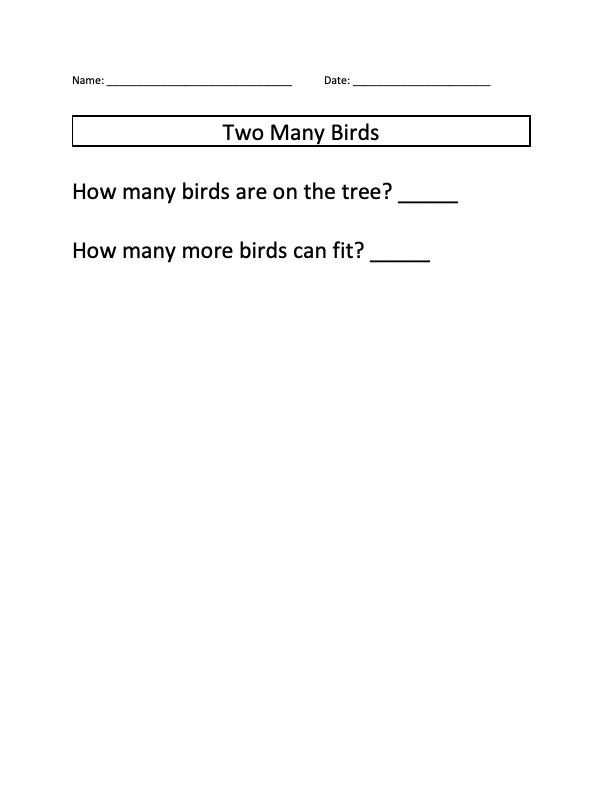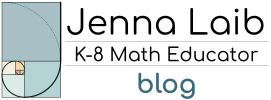I have been reading Allison Hintz and Antony Smith’s Mathematizing Children’s Literature (Stenhouse, 2022), and it has disrupted how I think about the use of children’s literature in math class. In my first blog post in this series, I named ideas that I have been wrestling with:
- Disruption #1: The book doesn’t need to be super mathy.
- Disruption #2: The book can and should be read multiple times, with multiple lenses.
- Disruption #3: Center student ideas and grow the experience together, rather than coming in with a pre-made plan.
In the second blog post, I described the planning and first reading of Two Many Birds, by Cindy Derby (MacMillan, 2020) in a first grade classroom.
This third blog post will describe the second reading: with a math lens.
Planning for the Second Read
In the past, I have selected children’s literature to bring into math class with a specific, narrow goal in mind. In my planning, I frequently thought about the students in the room: anticipating their thinking, and potential sticking points, and potential questions and tools to support their work. However, the initial inquiry was typically mine and mine alone.
Using the framework from Hintz & Smith’s Mathematizing Children’s Literature, we would conduct multiple reads of the same book, and use artifacts of student thinking in order to plan and shape subsequent learning experiences. Using this process made me feel like I was planning in collaboration with our students. Their ideas were infused into every part of the plan.
The Planning Template
Before the first reading, an Open Notice and Wonder, I had used a template from the book in order to organize some of my ideas. It was helpful for me to plan out places for pausing the story, and to mark those with sticky notes.
I decided to try using another planning template to help me prepare for the second read: what Hintz & Smith call a “focused read,” with a “math lens.”
The template urged me to think about how I would make connections — which ideas from the first Open Notice and Wonder read do I want to pursue? Why?
Just as I didn’t record every student idea on our chart from the first read, I didn’t record all of my thinking on the planning template, but the questions served as helpful prompts. The classroom teacher and I wanted to explore the part/whole relationships in how many birds are on the tree compared with how many more can join, given the maximum capacity of 100 birds. This would serve as a formative assessment before launching our next unit about tens and ones.
The second page of the template encouraged me to plan out the pausing points. I decided we would only read the beginning of the book again, and identified the questions I would use (and repeat) to invite thinking.
I also planned out how I might launch the story:
“Yesterday, as we read Two Many Birds, you noticed and wondered a lot of things about all fo the rules the ‘Bossy Owl’ created and enforced.
We talked about how the rules at the beginning were confusing. (show pages with signs) No parrots on Tuesdays! No long hairs! No bird baths! No pooping on the ground!
These rules were confusing, but they may have also served a purpose. Let’s look more at the biggest rule, the one introduced first: how many birds can go in the tree.”
Ideally, we would have had time for a third readaloud to dig deeper into the story, but our spring break was quickly approaching. After consulting the schedule, the classroom teacher and I realized we could only squeeze in one reading.
The Interactive Readaloud
When I walked into the first grade class, several students excitedly approached me.
“I’ve been asking for this book all morning!”
“I told my mom all about the book!”
“Do we get to read the book again?! It was hilarious!”
“I can’t wait!”
“I’m going to order it from Amazon!”
I was so glad that we’d given time and space to that Open Notice and Wonder.
“Are we going to read it again now?”
I smiled. “We’re going to read it again. We’re not going to read the whole thing again. Today we’re going to revisit parts of the book as mathematicians. So yesterday…”
Launching the Task
Students were curious about how many more birds could fit on the tree, and whether there would still be birds left in line.
“I think I know how many more fit on the tree when there’s 13!” Leon called out.
“Shhhh,” I responded. “That’s great! But also… let’s give other kids a chance to think about it. In fact, let’s all get a chance to think about it.”
It was time to introduce their recording sheets.
“You can choose to have any number of birds in your tree. Maybe you want to try 13, and figure out how many more will fit. Maybe you want to try 47. Or 72. It’s up to you! You’ll record your number here.”

“Then, you have to figure out how many more birds from the line can fit.”
I left lots of blank space for students to make their thinking visual. (#TeamBlankspace)
The classroom teacher and I introduced several tools that students would have available to them, if they so choose, mostly hundreds grids and ten frames. These pages would be available at the front of the room.
I wish I could tell you that students were disturbed by the fact that I’d left off their question about whether every bird in line could get onto the tree. I hoped we’d have time to take it up again at the end, but, unfortunately, that time didn’t manifest.
Students at Work
The classroom teacher and I monitored the students at work. First, I was curious to see what numbers they chose.

Most of the students chose either 12 or 13, like the page in the book. The dot plot shows a subsection of student number choices.

I was also curious about whether students would choose any of the additional tools we had made available (hundreds grid, ten frames).

Many students elected to draw the mathematical representation rather than use the printed version. Here are a few examples of student-drawn representations. Use the arrows to navigate left and right, to see all three examples.
The third student was the only one to attempt to draw a hundreds grid by hand. He struggled with the orientation of it — note the sloping rows. He made certain to include 10 columns, but then didn’t make 10 rows. He couldn’t remember how he got the 70 when asked, but he saw that there seemed to be two leftovers in that row that has 6 x’s.
Five-Practices Style Class Discussion
I selected two student work samples: Sara, who had drawn ten frames by hand, and Alex, who had used the page with the hundreds grid.
Sara originally wrote that there are 22 birds in the tree, and thus 88 more birds can fit. I asked her to show me where the 88 is in her representation, and she realized that she had counted one of the ten frames twice: once as another 10, and then another 8. She then adjusted her answer to show that there are 78 more birds that can fit on the tree.
I asked her to describe this process of changing her thinking to the class. Several other students announced that they, too, had changed their thinking.

“What is the same about what Sara and Alex did?” I asked the class.
“X’s and dots!” Came one excited reply. They had both figured out ways to show the part-whole relationship using different symbols. Several students had used this technique, which reminded me that this surfaced in a session a few weeks ago about representing addition using ten frames.
I reoriented us back to Alex’s work. I had assumed that Alex had counted each of the 87 squares one by one, and was poised to ask students for more efficient counting strategies, but he was quick to correct me. “I only did that when you asked me how I knew I was right. That’s not how I counted at all!”
“So how did you count it?”
Alex explained: “I counted by tens.”
“Where do you see the tens?”
Darren called out: “I see them there! There!” He eagerly pointed to the bottom row. “10!”
“Yes!” Alex agreed. As a class, we skip-counted in chorus by tens: “10, 20, 30, 40, 50, 60, 70, 80…”

I heard some students start to say “90,” only to trail off nervously.
“But it’s not 90!” Alex said. “That row is 10 minus the 3 that are used up. So it’s 7. And 80 and 7 is 87.”
I asked the students to help me find the 7, and then we labeled the 87 off to the side.
“Do you think these strategies would have worked for other numbers?” I asked the kids. “Some of you tried to solve this for 47 birds in the tree, or 72 birds in the tree.”
Students mostly murmured in agreement. I was waiting for someone to bring back to the part about how many more were in line, but, oops, the class was running late for art, and we were one day out from vacation.
Reflections
I might have planned out this exact task reading the book on my own.
But I feel confident in saying that it would not have held as much meaning for the students. They wouldn’t have had the space to enjoy the book, as a community. They wouldn’t have processed the story in the same way. We wouldn’t have had space to talk about the role of rules in a community, or sustainability, or any of the themes from the book, because I would have been laser focused on getting us to the task. Students might not have made the connection to the mathematical ideas in the book at all. They might have simply solved the task.
Because the classroom teacher and I crafted this activity in collaboration with students, I think they also felt empowered to use some of their own mathematical strategies rather than rehearsing something we had shown them. More students drew a mathematical representation (hundreds grid, ten frame, number line) than took the pages that we had provided. Student ideas were central to the entire experience.
In reviewing the three “disruptions” that challenged my usual course-of-business with children’s literature in math class…
- Disruption #1: The book doesn’t need to be super mathy.
- Disruption #2: The book can and should be read multiple times, with multiple lenses.
- Disruption #3: Center student ideas and grow the experience together, rather than coming in with a pre-made plan.
The mathematics involved in this ‘focused read’ is the mathematics we will continue to explore in the unit we start after vacation, and we now have a better understanding of what students are currently thinking. This wasn’t a fluffy diversion; it was meaningful assessment and learning.
Using Two Many Birds has affirmed that there is deep math everywhere, if we give students space to look and share and think.









